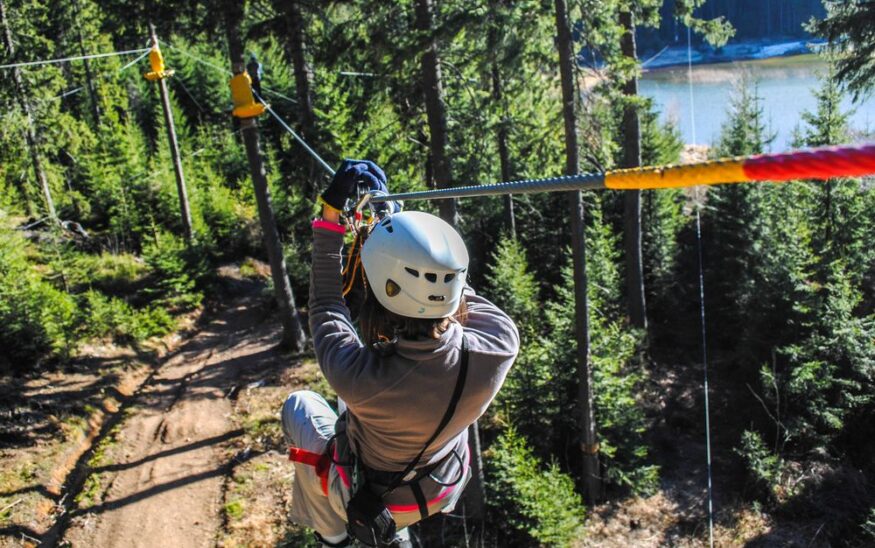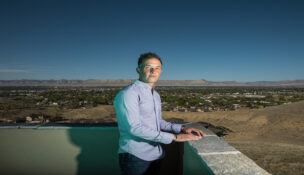It's time for some new warm-weather fun in ski country
Vail and Breckenridge are adding summer attractions
Allen Best //June 14, 2016//


It's time for some new warm-weather fun in ski country
Vail and Breckenridge are adding summer attractions
Allen Best //June 14, 2016//
Sometime in June, when lingering snow has vanished, customers at Vail will have new opportunities for both warm-weather thrills and mountain contemplation.
A small area of Vail Mountain will have zip lines, rope courses and a gravity coaster called the Forest Flyer. It’s off the forest floor, but you get to control the speed. Thrill-seekers will be able to survey the landscape high over the forest floor and, here and there, pause to contemplate the natural world.
Vail Resorts is packing its summertime amusements under the brand of Epic Discovery and is at work on something similar at Breckenridge. So are many other ski areas that operate on national forest land.
Some of these activities have been available on private land elsewhere. Ski areas in the East have had summer-centric attractions for years, and so has Utah’s Park City, as it is located almost entirely on former mining property. But Vail and most ski areas in Colorado are located largely or entirely on public land. A 1985 law granting operators 40-year special-use permits addressed only skiing and snow sports. There was no express authority for use of the mountains during summer and fall.
Despite the lack of clear authority, the Forest Service approved some activities. Most ski areas offered summer lift or gondola rides. Many tried to cash in on the mountain bike boom beginning in the 1980s. Most ski areas cobbled together attractions on the margins. Both Breckenridge and Winter Park, for example, installed concrete troughs called alpine slides in the late 1970s. At Vail, you could – and still can – take the gondola ride to a mountain-top venue – located on private land – where you can buy a meal, admire the views of Mount of the Holy Cross, and partake of a few activities like tubing at Adventure Ridge.
About a decade ago, at the instigation of Vail Resorts, the ski industry began lobbying Congress for clear authority for summer use of ski moutains. The industry’s trade organization, the Lakewood-based National Ski Areas Association, began working with then-U.S. Sen. Mark Udall, a Democrat from Colorado, on legislation. The law was passed in 2011. It specifically says that amusement parks, golf courses and water parks are not allowed on the ski mountains.
But the law left the U.S. Forest Service leeway in determining what exactly would be allowed. Vail Mountain was first to go through the process. The company was careful to embrace the idea of nature education. Working with The Nature Conservancy of Colorado, Avon-based Walking Mountains Science Center and the Forest Service itself, the company has created ideas that will instruct in the ways of nature. For example, children and adults will be able to get between the ears of a mule deer, to learn how the animals’ cone-shaped ears allow it to hear sounds differently, crucial if you’re prey, not the predator.
At Breckenridge, approval has been given for activities, but they will be a little different than those at Vail Mountain. Breck’s summer offerings should be open in another year or two. Vail Resorts is planning for more pared-down activities at Keystone. Other ski ¬areas in Colorado have waited to see the outcome of Vail’s guinea-pig process but have now started to submit plans for review.
For ski areas, summer attractions offer a way to grow profits and put existing infrastructure to greater use. If you think about ski areas, their primary product is uphill transportation. Sure, they sell burgers (organic at Vail), ski lessons and other add-ons. Improved grooming makes the lift ride more valuable. But it’s all built around uphill transportation. And, for the most part, it’s a very profitable business. As a public company, Vail’s records are open to public scrutiny, and the company has done very nicely since it went public at $16 a share at its IPO in 1997 to $128 in early April, with many handsome dividends along the way.
Michael Berry, executive director of the National Ski Areas Association, says ski areas have long recognized the potential for their uphill capacity.
“It’s just one of those things that’s time has come, and I think the huge advantage we have is the uphill transportation and gravity. Those, in combination, create the opportunity to do some fun and interesting things.”
Nobody thinks a handful of summer activities will resemble the draw of sliding on freshly fallen snow. Blaise Carrig, executive vice president of Vail Resorts, says the company hopes to reduce summer operating losses and perhaps keep more staff on a year-round basis. At best, summer operations can move into the black.
Rick Kahl, the Boulder-based editor of Ski Area Management, a trade magazine, also sees the summer amusements as something of an insurance policy.
“In the ski business, you really are dependent on mother nature,” he says.
A case in point was the extremely warm weather of December in Vermont, New York and Pennsylvania. It was too warm to even make snow. One ski area even opened its summer activities at Christmas. Harry Frampton, who headed what is now Vail Resorts in the early 1980s, sees summer activities as a good thing. Just 20 percent of skiers are experts, he says, and not everybody is equally inclined toward athleticism during summer.
“What they’re doing is broadening the customer base, and I think that’s terrific. If you want to climb 14ers in isolation or in small groups, you can still do that. It’s not like there’s no backcountry in Colorado.”
Frampton, the co-founder of East West Partners, a real estate development company with operations in both Denver and the Vail Valley, also hopes the summer activities broaden into fall. Summer, he says, “is really a seven-week season, and I hope that Vail can extend that season from mid-August to early October. With the changing aspen leafs, what a beautiful time of year.”


























